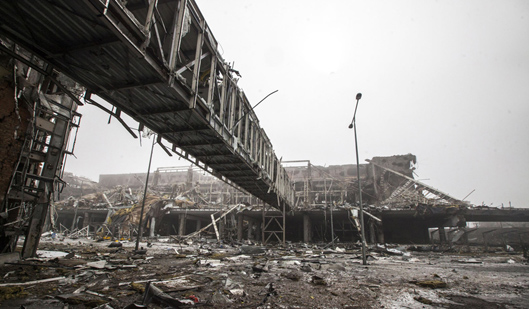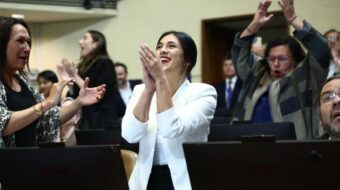
Some 300 U.S. military personnel are carrying out a training program for the Ukrainian National Guard near the city of Lviv, in the far west of the country.
The U.S. troops are veterans of the wars in Iraq and Afghanistan, and hope to transfer some of the skills gained in those conflicts to about 900 Ukrainian guardsmen.
The units to be trained include former private militias whom the government of Ukraine earlier had absorbed into the National Guard. Included, according to the Ukrainian government, is the Azov Battalion, whose ranks include many neo-nazi, fascist, and ultra-nationalist elements. However, U.S. officials say Azov will not be included.
If Azov is included, it will constitute a major scandal and provocation, especially in the eyes of Russia which already feels threatened by NATO being right up against its borders.
The Western governments and the corporate press say that the characterization of the neo-nazis as fascists is just Russian “propaganda.” There is, however, plenty of independent evidence to the contrary – accepted even by commentators who are not admirers of Russia’s President Vladimir Putin.
The independent battalions came into being a year ago when, following the overthrow of President Victor Yanukovych, the industrial Donbas region of Eastern Ukraine rebelled against the new right-wing government in Kiev. The local forces that took power in the Donetsk and Luhansk oblasts (provinces) managed to defeat, disarm or win over many Ukrainian soldiers, and the armed effort of Kiev authorities to bring the region back under control seemed to be faltering.
So the government agreed to give the right wing militias their head, while at the same time refusing to negotiate with the eastern dissidents they call the “separatists.”
Many people in Eastern Ukraine are predominantly Russian speaking and have close economic and cultural ties to Russia next door. They were alarmed when the Ukrainian Parliament, the Rada, voted to withdraw recognition of the Russian language as co-official with Ukrainian, even though the acting president at the time vetoed the bill. The alarm increased when neo-nazis allied with Kiev committed acts of extreme violence, including a brutal massacre in Odessa last May. https://www.peoplesworld.org/ukrainian-rightists-burn-alive-39-at-odessa-union-building/
The ultra-right Svoboda and Pravy Sektor (Right Sector) political organizations indeed have historical links to Ukrainian fascism, which throve in the period from the 1930s to the 1950s. Fascist organizations of that time massacred thousands of Jews as well as ethnic Poles and Hungarians.
During the Second World War, the main fascist organization, headed by Stepan Bandera, offered to collaborate with the German Nazis. Initially the Nazis would did not accept this and arrested the Ukrainian nationalists, whom they considered to be “Untermenschen.” But later in the war, there was active collaboration.
On April 9, the Ukrainian Rada passed legislation abolishing communist ideology and forbidding both nazi and communist symbolism, portraits, statues etc. Denial that the Soviet regime was a criminal entity would be a crime also.
The law is waiting for President Petro Poroshenko’s signature, but ultra-nationalist crowds have already begun tearing down statues of Lenin and other Soviet-era leaders. The Communist Party of Ukraine is under persecution, and its Secretary General , Petro Symonenko, has been told that he is a target for criminal prosecution. On Jan.10, Ukraine’s prime minister, Arkady Yatsenyuk, shocked many by describing World War II as the time when “Russia invaded Germany and Ukraine.”
The context for the arrival of the U.S. troops is important. On the one hand, there is a shaky cease fire between the Donetsk and Luhansk autonomist militias and the Ukrainian government. This cease fire was negotiated in Minsk, Belarus, among Russia, Ukraine, France, Germany and the Ukraine, after it became clear that the Ukrainian military was not going to be able to recapture the Donbas and might lose more territory. The initial elements of the cease fire granted provisional autonomy to Luhansk and Donetsk within Ukraine, among other things.
But this cease fire is only reluctantly accepted by President Poroshenko, and the ultra-right militias are against it.
Another piece of the context is that Ukraine is broke and desperately trying to get a bailout loan from the International Monetary Fund (IMF). In exchange, the IMF is demanding economic concessions. These include new austerity measures in the Ukraine, already the poorest country in Europe. The deal would be based on “free” trade principles that will do great harm to the Ukrainian economy and increase unemployment. The Ukrainian government wants eventual integration into the European Union’s structures, even though the country was offered a better deal by Russia in 2013.
The tradeoff for the bailout also includes clipping the wings of the freewheeling Ukrainian “oligarchs.” Whether a government dominated by oligarchs like President Porshenko who is known as the “chocolate king” because of his control of the candy industry, can actually do this is as big a question.
Ukraine’s creditors are taking a tough stand against the country’s call for a debt restructuring. For the moment the Ukrainian government is continuing to demand this.
The United States and the European Union have imposed sanctions on Moscow to pressure it to cease providing aid to the Donbas autonomists. However, Europe has doubts about this, because sanctions on Russia will harm European trade with Russia, which is considerable.
Photo: U.S. troops sent to Ukraine on a “training” mission are working with some of the same forces that caused the destruction in Eastern Ukraine as depicted above in a decimated airport in Donetsk. | Igor Ivanov/AP

MOST POPULAR TODAY

High Court essentially bans demonstrations, freedom of assembly in Deep South

Zionist organizations leading campaign to stop ceasefire resolutions in D.C. area

U.S. imperialism’s ‘ironclad’ support for Israel increases fascist danger at home

UN warns that Israel is still blocking humanitarian aid to Gaza







Comments